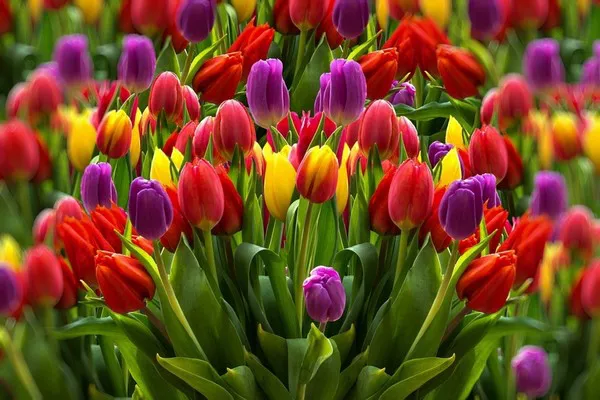Tulip flowers, known for their vibrant colors and distinctive shape, have captivated human hearts for centuries. Beyond their aesthetic appeal, tulips have played a significant role in various aspects of human life, from cultural symbolism to horticultural practices. In this article, we delve into the multifaceted uses of tulip flowers.
A Historical Overview
Tulips have a rich history that dates back to the Ottoman Empire in the 16th century. Originating from Central Asia, these flowers gained popularity and eventually found their way to Europe, particularly the Netherlands, where they became a symbol of wealth and status during the Dutch Golden Age. The “Tulip Mania” of the 17th century, characterized by a speculative frenzy around tulip bulbs, remains a notable chapter in economic history. Today, tulips continue to be an emblem of beauty and cultural heritage.
Cultural and Symbolic Significance
Tulips have held a plethora of meanings in various cultures throughout history. In Persian culture, they represent love and passion, while in Turkish tradition, they signify paradise on Earth. In the language of flowers, or floriography, different colors of tulips convey distinct emotions. Red tulips symbolize deep love, yellow tulips represent cheerful thoughts, and purple tulips embody royalty. These cultural and symbolic associations make tulips a popular choice for gifts and celebrations.
Horticultural Importance
Tulip flowers have not only captured the hearts of enthusiasts but have also become a focal point in horticulture. Tulip cultivation requires careful attention to soil composition, sunlight, and temperature. The science of hybridization has led to the creation of numerous tulip varieties, each with its unique characteristics. From single-flowered to double-flowered, and from early bloomers to late bloomers, the diversity within the tulip family offers a wide array of choices for gardeners and landscapers.
Tulips in Gardens and Landscapes
Tulips are a beloved feature in gardens and landscapes around the world. Their vibrant colors and elegant forms make them a staple in springtime displays. Tulip festivals, held in various countries, draw innumerable visitors who come to witness the breathtaking beauty of these flowers in full bloom. In landscaping, tulips are often used to create visually striking arrangements, from meticulously organized color palettes to more naturalistic, wildflower-inspired designs.
Economic and Commercial Aspects
While the “Tulip Mania” of the 17th century was an extreme economic phenomenon, tulips continue to hold economic significance. The flower industry, including cut flowers and bulbs, generates substantial revenue globally. The Netherlands remains a major hub for tulip cultivation and export, with the Keukenhof Gardens showcasing a stunning assortment of tulip varieties each year, attracting tourists and enthusiasts alike.
Tulips in Art and Literature
Tulips’ influence extends beyond the natural world and into the realms of art and literature. Renowned artists like Vincent van Gogh and Claude Monet immortalized tulips in their paintings, capturing their vivid hues and delicate petals. In literature, tulips have been used as metaphors for various human experiences, from love and desire to transience and mortality. This integration into the artistic and literary narrative reflects the enduring impact of tulips on human expression.
Tulips in Medicine and Cuisine
Beyond their visual allure, tulips have found their way into diverse areas such as medicine and cuisine. In traditional herbal medicine, tulip extracts have been used to treat ailments such as headaches and skin conditions. However, it’s essential to note that tulips contain alkaloids that can be toxic if ingested in significant quantities. Culinary enthusiasts have also experimented with incorporating tulip petals into salads and garnishes, adding a touch of both flavor and aesthetics to dishes.
Conservation and Preservation Efforts
As with many natural treasures, there is a growing concern for the conservation of tulip diversity. Habitat loss and climate change threaten various plant species, including tulips. Conservation efforts are underway to protect wild tulip populations and preserve the genetic diversity of cultivated varieties. Botanical gardens and research institutions collaborate to safeguard these valuable resources for future generations.
Tulips in the Digital Age
In the modern era, tulips have seamlessly integrated into the digital landscape. Social media platforms and online gardening communities provide spaces for enthusiasts to share their tulip-growing experiences, photographs, and knowledge. Virtual tours of tulip festivals and gardens enable people from around the world to appreciate the beauty of tulips without geographical limitations.
Conclusion
Tulip flowers have transcended their role as mere botanical specimens to become symbols of culture, history, and human expression. From their captivating presence in gardens to their deep-rooted significance in various cultures, tulips continue to be cherished and celebrated. Their journey from the gardens of Ottoman palaces to the digital screens of today exemplifies their enduring appeal and adaptability. As we continue to find new ways to appreciate and engage with tulips, we ensure that their legacy remains as vibrant and captivating as their petals.


